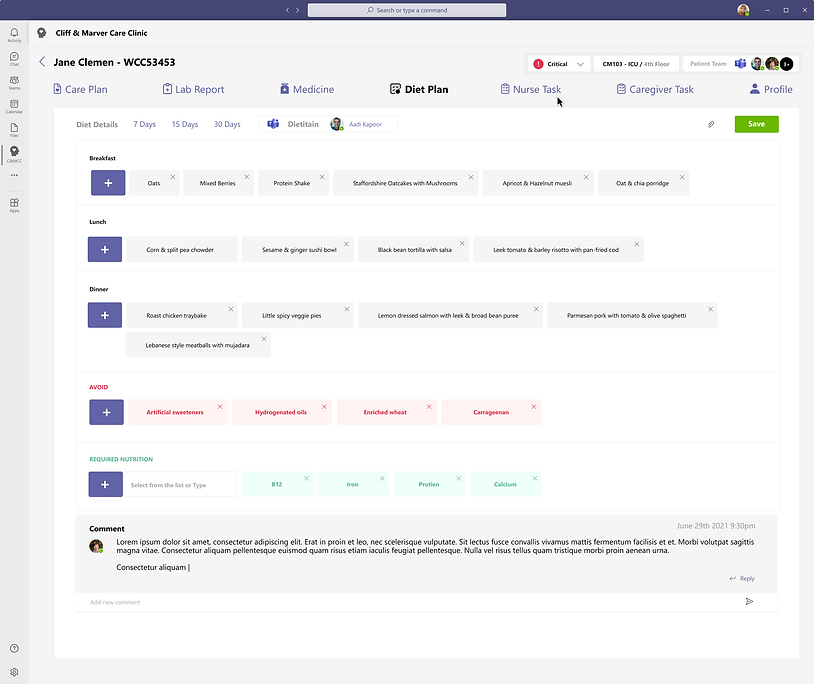top of page
Girish Suryajoies
Principal UX Designer
Microsoft - Healthcare
role: Senior Design Consultant
team: 1
responsibility: Design & Strategy
duration: 2 Months
Introduction
In many healthcare settings, clinicians face significant challenges managing patient information dispersed across multiple sources, often involving time-consuming, inconsistent, and paper-driven processes. Communication among doctors, nurses, and caregivers relies on fragmented and insecure channels such as paper notes, phone calls, WhatsApp, texts, and emails, which risk breaches of patient privacy and reduce the quality and efficiency of care. Patients receive less direct clinical time, and discharge processes are delayed due to slow or missing care plan coordination.
To address these challenges, a Power App integrated within Microsoft Teams is proposed to create a secure, centralized, and efficient collaboration and communication platform for in-patient care management. This solution leverages Teams’ built-in capabilities—secure collaboration, bots, task management (ToDos, Planner), scheduling (Bookings, Calendar), file sharing, and multimedia—to streamline workflows, improve transparency, and enhance patient outcomes.
Requirement
-
Consolidate patient data and care plans from diverse EHR and healthcare systems into a unified Teams environment accessible by clinicians, nurses, and caregivers.
-
Replace paper-based records and insecure communication channels with secure, digital collaboration tools compliant with privacy regulations.
-
Enable efficient multi-tasking and real-time communication to reduce administrative burden on clinicians, allowing more focus on patient care.
-
Support coordinated care planning, scheduled patient round-ups, and timely updates among the care team.
-
Ensure patient information is shared securely and only with authorized users.
-
Improve patient experience by enabling clinicians to dedicate more time to direct care and ensure timely discharge coordination.
User
-
Doctors: Need streamlined access to consolidated patient information, easy communication with the care team, and tools to manage care plans and schedules.
-
Caregivers: Require visibility into care plans and communication tools to coordinate patient support effectively.
-
Nurses: Require timely updates, task management, and scheduling tools to facilitate patient rounds and care coordination.
Goal
Create a secure, integrated collaboration and communication solution within Microsoft Teams that streamlines workflows, reduces administrative burden on clinicians, enhances patient care coordination, and ensures compliance with privacy regulations.
Decision Design - Story driven UX framework
-
Integration into Microsoft Teams: Embed the Power App as a tab within Teams, allowing clinicians to access patient and care plan information without switching platforms. Use Teams’ chat, file sharing, notifications, calendar, and planner capabilities for real-time collaboration.
-
Simplified Information Access: Design an intuitive user interface focused on displaying only the most relevant patient data and care plan information per user role, reducing information overload.
-
Digital Care Plan Management: Replace paper documentation with digital forms and workflows, enabling clinicians to update patient rounds and care plans on mobile or desktop within Teams.
-
Secure Communication Channels: Enable HIPAA-compliant messaging, shared notes, and task assignment within Teams to ensure privacy and regulatory adherence.
-
Support for Multitasking: Allow users to perform batch actions such as bulk approving care tasks or viewing multiple patient summaries simultaneously.
-
Visual Data Dashboards: Integrate graphical summaries (charts, KPIs) on patient status, care plan progress, and discharge readiness to facilitate quick decision-making.
-
Role-Based Access Control: Ensure clinicians see only the modules and patient information appropriate to their role or department, managed via secure permissions and authentication within Teams and Power Platform.












AI Integration in Healthcare
-
Intelligent Data Aggregation: Use AI to automatically aggregate and prioritize relevant patient data from disparate EHR systems to present clinicians with a concise, actionable summary in real-time.
-
Natural Language Processing (NLP) Bots: Deploy AI-powered chatbots within Teams to assist clinicians in querying patient data using natural language (e.g., “Show me today’s care plan for patient X”) and triggering workflow actions.
-
Predictive Analytics: Leverage AI to predict patient discharge readiness, flag potential care delays, and identify patients at risk for readmission, helping prioritize clinician workflows.
-
Automated Task Suggestions: AI can suggest next best actions for clinicians based on patient condition trends or care protocols, reducing cognitive load and administrative overhead.
-
ecure AI-Powered Communication Insights: AI can monitor communication patterns for compliance risks (e.g., sensitive information leak) and prompt secure messaging practices.
bottom of page